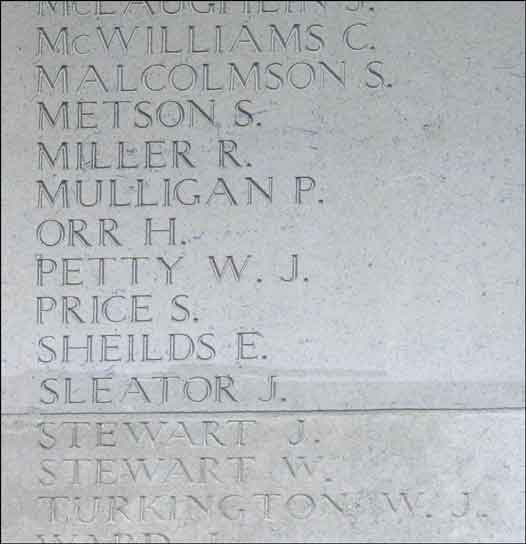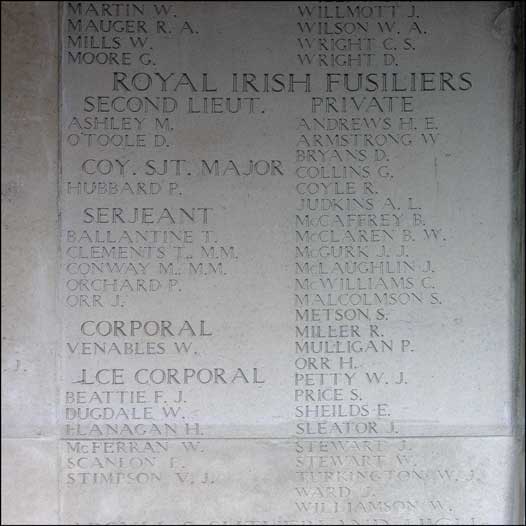![]() In memoriam
In memoriam ![]()
Squadron Quartermaster Sergeant William James Turkington

William James Turkington was born on 15 November 1891 in Killygarvan, County Tyrone, the fifth of seven children of farmer William James Turkington and his wife Hannah (née Millar). Between 1896 and 1901 the family moved to Belfast, where William's father found work as a railway porter. At the time of the 1911 Census William was living with his parents and siblings at 15 Ulsterville Gardens, and working as a clerk for the Great Northern Railway.
Turkington enlisted in the 6th (Inniskilling) Dragoons Service Squadron at Belfast between 25 November 1914 and 9 February 1915 (No. UD/207). On 6 October 1915 the squadron, which was then serving as divisional cavalry to the 36th (Ulster) Division, embarked for France. Turkington, however, remained at the reinforcements depot at Enniskillen.
By June 1917 he had risen to the rank of squadron quartermaster-sergeant. Then, according to a later report in the Belfast News-Letter, "in order to get to the front more quickly he gave up his stripes and proceeded on active service". There he joined his squadron, which since June 1916 had been part of the 2nd North Irish Horse Regiment, serving as corps cavalry to X Corps.
In August-September 1917 the 2nd NIH Regiment was disbanded and its men, following training at the 36th (Ulster) Division Infantry Base Depot at Harfleur, were transferred to the Royal Irish Fusiliers, an infantry regiment. Most, including Turkington, were transferred on 20 September and posted to the 9th (Service) Battalion – renamed the 9th (North Irish Horse) Battalion – joining it in the field at Ruyaulcourt. Turkington was issued regimental number 41173.
In November and December 1917 the 9th Battalion played a role in the Battle of Cambrai, first going into action in the attack on the village of Moeuvres on 22-23 November. The battalion war diary for those days reads as follows:
[22 November] The Battn moved up at 6.30 a.m. to a position N. of Bapaume & Cambrai Road arriving at 8.30 a.m. Here the Battn waited for an order to attack Inchi when Moeuvres was taken by the 12th Royal Irish Rifles. At 11.45 a.m. the 12th R. Ir. Rifles captured village of Moeuvres. It was unable to clear trenches East of village. At 5.30 p.m. Battn moved up to support 12th R. Ir. Rifles in the village of Moeuvres. At 5.45 p.m. 12th R. Ir. Rifles reported driven out of village. At 8.30 p.m. Battn less 'D' Coy counter attacked village of Moeuvres but was driven back to trenches immediately south of the village, where it took up a defensive position for the night.
[23 November] Battn attacked Moeuvres at 10.30 a.m. At 11 a.m. Battn reported in village. At 11.45 a.m. enemy counter attacked from trenches West of village. 12.15 p.m. counter attack driven off. At 4.30 .p.m village evacuated by Battn on account of supports not coming up. 5 p.m. 'C' & 'D' Coys took up position on Sunken Road South of village and 'A' & 'B' Coys went back to trenches North of Bapaume & Cambrai Road.
Casualties for 22nd & 23rd: Officers killed 1. Officers wounded 6. ORs 82 casualties.
Turkington was one of the 82 casualties, though whether he was killed on the 22nd or 23rd is unknown.
As he has no known grave, Private Turkington is commemorated on the Cambrai Memorial, Louverval, France, Panel 10. If his body was recovered by the Germans after the battle, it was probably buried in the German extension to the Moeuvres Communal Cemetery, and after the war re-interred in the British extension, in which lie 263 unidentified casualties.

Images Copyright © Phillip Tardif with all rights reserved as set out in this Use of Material policy.
This page last updated 27 June 2023.
